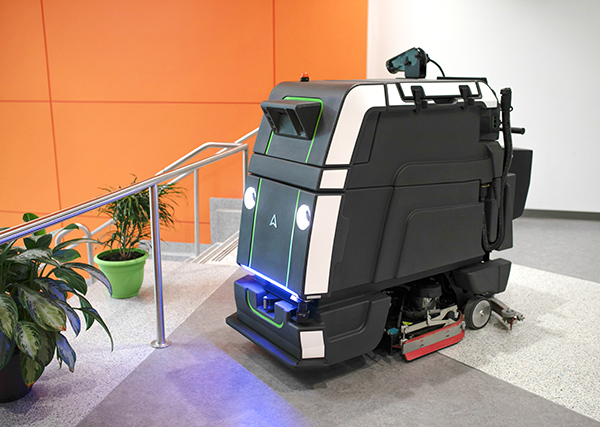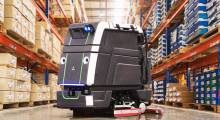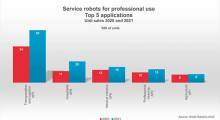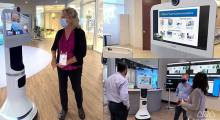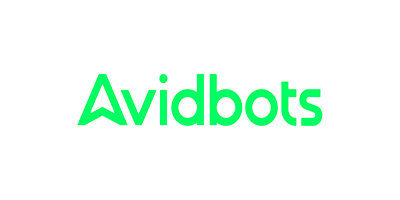While many mobile robot providers jumped on the disinfection bandwagon during the COVID-19 pandemic, a few were already involved in cleaning applications. Avidbots Corp. today announced that it has expanded the functionality of its Neo 2 floor-scrubbing robot with a sprayer that can disinfect high-touch surfaces more economically and safely than other approaches.
“The days of having single-purpose robots for specific tasks are behind us. A robot must be multi-functional to meet the ever-evolving needs of customers,” stated Pablo Molina, co-founder and chief technology officer of Avidbots. “With the Disinfection Add-On, our customers can disinfect surfaces for a few hundred dollars per month—this is more than 10x savings when compared to having a separate robot or human completing the same task.”
“The Disinfection Add-On truly multiplies the value of the Neo platform,” he added. “As facilities across the globe reopen and welcome back their employees, customers, and visitors, Neo provides disinfection at a low cost to help our customers keep up with the new normal, creating a safe and healthy environment.”
CDC recommends disinfection
The Centers for Disease Control and Prevention (CDC) recommends the daily cleaning of high-touch surfaces to sufficiently remove the virus that causes COVID-19, including the Delta variant. It encourages more frequent cleaning of surfaces in high-traffic areas.
However, not all operators are cleaning properly or consistently. Facility managers are working hard to meet increased cleaning protocols and show proof that facilities are safe. Disinfecting seating, work surfaces, garbage cans, doors, and kiosks can be time-consuming, said Avidbots.
The Disinfection Add-On allows labor to be reallocated to value-added activities and create a healthier and safer environment, the company said.
“We want to do our part in helping to slow the spread of the [COVID-19] virus,” Molina told Robotics 24/7. “Many facilities are facing budget and labor difficulties and have reduced cleaning. Our robots can navigate dynamic environments, and we're happy to have a system that's reliable, operational, and connects with our software.”
The Neo add-on uses electrostatic spraying technology to ensure uniform 3-D coverage of surfaces, said Avidbots. In addition, the sprayer uses less chemical solution than other methods. This approach ensures that chemicals do not dry out in the air before reaching the target, according to the company.
“We researched a lot of different technologies, including UV [ultraviolet light] and misting,” recalled Molina. “We picked a mechanical approach, and we can run our robot without major safety concerns like with UV or fogging. We wanted to release sooner, but we wanted good quality and feature set.”
Avidbots tests Neo Disinfection Add-On at RIT
Founded in 2014, Avidbots offers service and support to customers on five continents. The Kitchener, Ontario-based company has been beta testing the mobile robot sprayer at the Rochester Institute of Technology (RIT) in New York.
“Going back four or five years now, we got our first Neo,” said Derek Sylvester, director of building environmental services at RIT. “We have roughly 7 million sq. ft. of space, built in the 1960s, with 15-ft.-wide institutional corridors. We needed to get more work done with less people. With wages up almost 25% across the board, the return on invesment of another neo is an easy justification.”
“Fast-forward to 2020, and robots continued cleaning for the fewer students and staffers still on campus,” he told Robotics 24/7. “In New York State, part of the safety plan required us to do additional cleaning every day to get government approval to open. Robots were ideal for that.”
“Coming into the disinfection side, Pablo and I brainstormed on the phone, and he got the customer perspective,” said Sylvester. “We were doing Clorox 360 electrostatic spraying, and we got in on the ground floor and tested the robot. We looked at UV, but the environmental health and safety were against it because of the risk of burns. It also takes a long time to do the work, also risking exposure.”
“As we welcome students, faculty and staff back to campus, we are focused on ensuring the safest environment possible,” he said. “Innovation is the cornerstone of the Rochester Institute of Technology, and we’re always looking for breakthrough technology that can solve our day-to-day challenges.”
“We did customer discovery and called 30+ customers,” said Molina. “Their interests have changed over time, and we did a lot of testing at a couple of airports and at a local college in Canada when borders were closed. We learned lots of details for proper disinfection—not to spray too much or too little.”
RIT has eight senior custodians, each of whom supervises groups of 12 to 22 cleaning staffers. “Whenever Neo is deployed, the senior custodians will set it up and then continue with the rest of their duties,” Sylvester said. “We know long their routes will take, and they'll meet the robot at the end of two to three hours, clean it out, and put in new batteries.”
“It's not even an hour's worth of manpower for an eight-hour shift, and we run closer to 12 hours,” he said. “We're not replacing people—we can take those hours and put them into more important stuff. It's an important conversation, to dispel the stigma of robotics.”
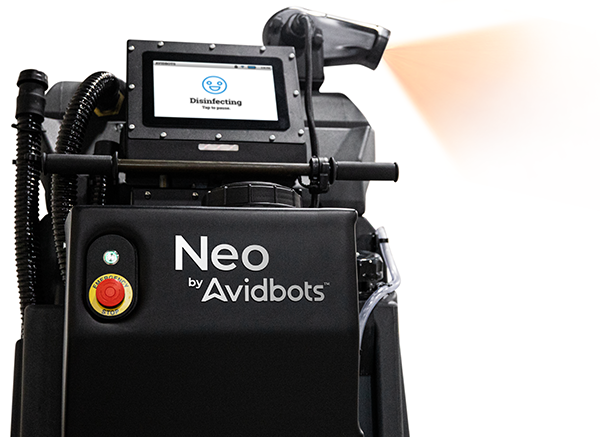
Peace of mind as important as hygiene
“One of the most pressing challenges is not only maintaining a clean campus, but [also] people wanting to see what’s being done to keep them healthy,” noted Sylvester. “The visibility of our Neo fleet autonomously disinfecting common-area touch points and cleaning floors provides peace of mind.”
“The custodial staff has always been there, behind the scenes,” he added. “While we can't clean every point across campus, people see disinfection being done, and they feel more comfortable and safe. We're open and running full-bore with 16,000 students.”
How have people reacted to Neo? “When students come out of classes, there are hundreds in the halls, and they step to the side for the robot while still on their phones,” said Sylvester. “They're accustomed to seeing robots on campus, and we've had faculty and students put lights on them at the holidays.”
RIT is currently running three Neos in two buildings, as well as in tunnels between residence halls for snowy season, Sylvester explained. “We have $250 million in construction going on currently, but we expect to buy more robots,” he said.
RIT also has several lawnmowing robots and is considering systems for food deliveries and carpet cleaning, said Sylvester.
Software and more applications
Like Neo, the Disinfection Add-On is powered by the Avidbots AI Platform, said Avidbots. Neo can avoid people and obstacles and maximize cleaning and disinfection productivity while minimizing human intervention, said the company.
At the same time, the Avidbots Command Center provides detailed reporting and performance measurement for monitoring, managing and tracking Neo remotely and in real time.
“A big focus of our work is on the AI platform,” said Molina. “We also have remote assistance. The user needs to be able to press 'Go,' walk away, and come back at the end. That's always been our philosophy.”
Avidbots noted that its Neo robots are already in use in locations such as airports, transit hubs, and warehouses. “Locations that have high traffic and therefore require daily disinfection have a lot of interest,” Molina said. “We like talk to customers in the field, and robots need to become tools that are trusted.”
With the idea of multi-application robots, what is Avidbots looking at next?
“We have no super-concrete plans yet, but people want to see robots do two to four things,” replied Molina. “We want to first deliver on disinfection and support. To rent a dedicated system or do disinfection by hand would be 10 times as much. Automated shelf scanning and delivery are the future.”
“I get very excited about the economics of multi-application robots and what they can become. It's like computers in the '70s or phones—they could do more things in more places,” he added. “At Avidbots, we want to bring robots into the real world and unleash them to help people and organizations. While you wouldn't pay $3,000 for a concierge at the door, if you could pay a few hundred more for a robot that does multiple things, why not?”
About the Author
Follow Robotics 24/7 on Linkedin
Article topics
Email Sign Up

